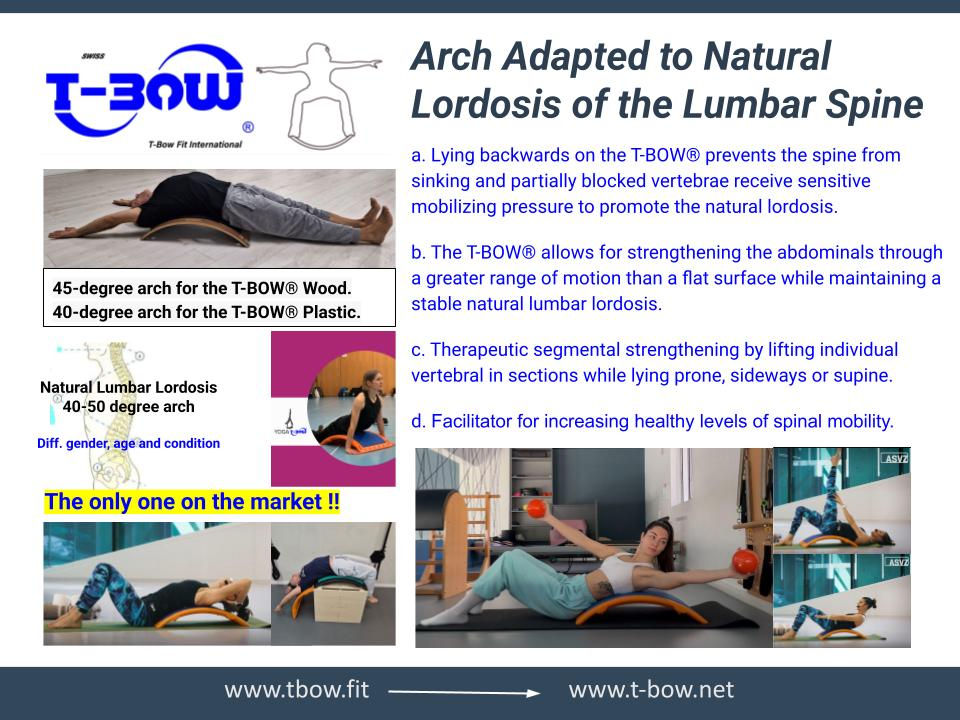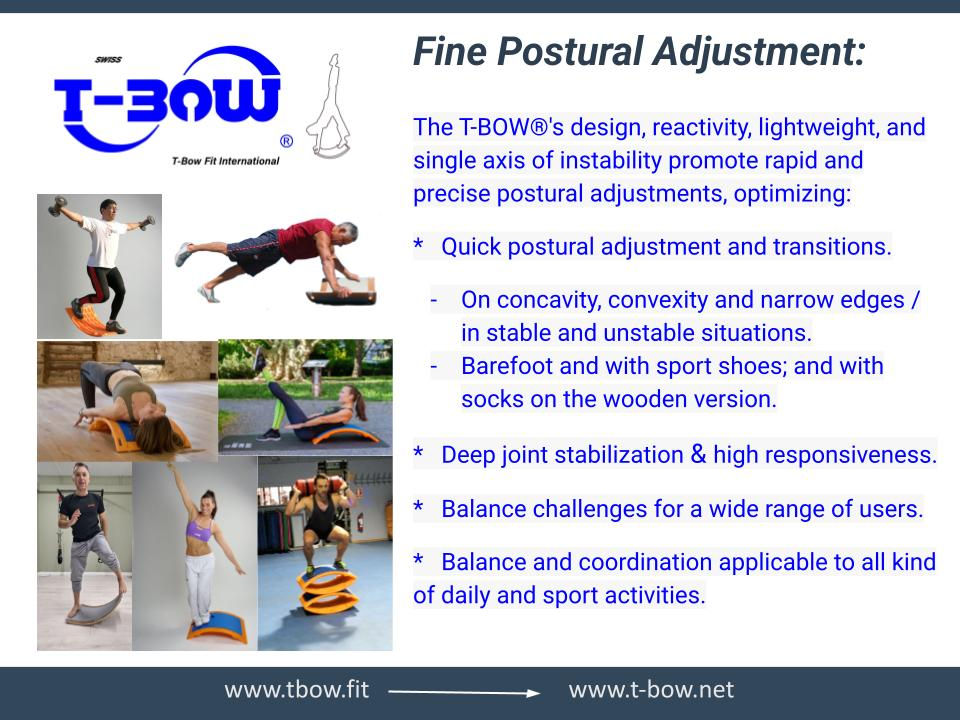Back Stretching & Mobility on the T-Bow® in its Stable Position
- T-BOW TRAINING AND THERAPY
- Mar 5, 2023
- 4 min read
Updated: Aug 10

Summary of the basics for back stretching and mobility on the T-Bow® in its stable position with applications to Training and Therapy for all ages, in group fitness and personalized training.
Back Stretching & Mobility on the T-BOW®
in its Stable Position
by Sandra Bonacina (Zurich University, SZ)

The curvature of the T-BOW® has the radius of a normal curved lordosis of the lumbar spine (approx. 40 degrees for the classic version and 45 degrees for the wood version). For people with too much lordose it corrects back to normal when they lie backwards on it and push the spine on the T-BOW®. For people with less than normal lordose the T-BOW® stretches the spine to the normal lordose. Many people that sit too long have a reduced flexile lordose of the lumbar spine and stress on the intervertebral discs. So just lying backwards over the T-BOW® and activating the belly muscles helps to arrange the vertebra into the correct position and additionally gives all organs in the belly more space.
T-BOW® Arch Adapted to Natural Lordosis of the Lumbar Spine in Healthy Adults
a. Lying backwards on the T-BOW® prevents the spine from sinking and partially blocked vertebrae receive sensitive mobilizing pressure to promote the natural lumbar lordosis.
b. The T-BOW® allows for strengthening the abdominals through a greater range of motion than a flat surface while maintaining a stable natural lumbar lordosis.
c. Therapeutic segmental strengthening by lifting individual vertebral in sections while lying prone, sideways or supine.
d. Facilitator for increasing healthy levels of spinal mobility.

This radius of a normal curved lordosis of the lumbar spine is a small but enough challenge for the spine and at the same time assure security and stability, supporting the back anatomically correct, and avoids the possibility to bring the spine to limits that could be too much pressure on the vertebrae, as may happens in more pronounced curvatures, and at the same time this gives the T-BOW® a healthy and therapeutic applicability that reaches a very wide range of people.

The high reactivity of the T-BOW® (with a mat on the convex part that is comfortable and very sensitive to body contact) improves the kinesiological fixation of the back and the possibility of a very stable localization of the spinal curvatures by providing a very fine tactile and kinesthetic feedback that allows better postural space-time adjustments with high precision of any longitudinal and lateral imbalance of the pelvis-back, the shoulder girdle and the neck, thus all the spine can be properly balanced and perfectly positioned (unlike softer and less reactive surfaces that cause a sinking of the back and slower postural feedback, limiting fine postural-movement adjustment).

Fine Postural Adjustment
The T-BOW®'s design, reactivity, lightweight, and single axis of instability promote rapid and precise postural adjustments, optimizing:
* Quick postural adjustment and transitions.
- On concavity, convexity and narrow edges / in stable and unstable situations.
- Barefoot and with sport shoes; and with socks on the wooden version.
* Deep joint stabilization & high responsiveness.
* Balance challenges for a wide range of users.
* Balance and coordination applicable to all kind of daily and sport activities.

Different positions on T-BOW® and postures/mobilizations of pelvis-legs, shoulder girdle and spine make mobilization and stretching exercises emphasize upper/lower back extensions, flexions, rotations, lateral tilts and combinations of previous actions.
The executor is relieved on supine position on the T-Bow® since the spine can be mobilized and stretched physiologically.
Small rocking movements for relaxation will also make a special difference due to the convex anatomical shape of the T-Bow® and thus mobilization exercises are optimized.
When lying on your back on a T-BOW® stable, partially blocked vertebrae cannot sink like they would on a large Exercise Ball or on a Bosu, but receive a slight mobilizing pressure. It can also be segmentally mobilized and stretched.
It is of special importance the combination of back extensions and rotations on the T-BOW® in order to keep healthy levels of spine mobility and stretching of the back.

Its arch perfectly supports the body if you lie sideways or prone over the T-BOW® and keeps the torso in a neutral position.
Thus, the T-BOW® allows the optimization of highly reactive and precise static-dynamic balance situations in different postural arrangements, accessible to a large number of individuals.

This article is focused on the stable T-BOW®, but alternating stable and unstable back extensions on the T-BOW® is a very interesting option to enrich and optimize the extensions of the global posture. Note that the unstable double T-BOW® also has only 1 axis of imbalance and keeps the high reactivity and stability.

Movement · Vitality · Fun
"With the T-BOW® we have a wonderful tool to get people moving. Movement means being alive and healthy. We feel fortunate to bring health and stress reduction with high quality programs to train all aspects of fitness and deep joint stability. So many people have fewer back and neck problems using the T-BOW®." "It is fantastic that we can use it in all ages and groups. I am convinced that the T-BOW® will be a reference throughout the world for its high quality proven for years."
Sandra Bonacina, inventor of the T-BOW® and professor of physiotherapy and fitness at Zurich University (Switzerland).

ASVZ
Academic Sports Association Zurich
















Comments